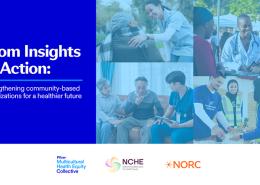Steps For Managing Finances and Health Insurance After a Cancer Diagnosis

Cost should never be a barrier to receiving cancer treatment, yet there are people who are unable to pay their medical bills, go bankrupt1, or worse, forgo treatment2 so as not to burden their family with high medical costs.
This financial burden is often referred to as ‘financial toxicity' and it can severely affect emotional and physical health. When a patient experiences financial challenges, they’re less likely3 to take their prescribed medications because they can’t afford the copayments. In fact, studies show that cancer survivors with financial burden had significantly higher rates of depression4 and cancer patients who filed for bankruptcy because of their medical bills are reported5 to have a higher mortality risk.
Fortunately, there are ways to minimize the financial burden of a cancer diagnosis. Triage Cancer, a nonprofit dedicated to providing practical and legal education for cancer survivors, and PlatformQ Health, a leading provider of virtual healthcare events, in collaboration with Pfizer Oncology, have teamed up to create an online video education series on CancerCoachLive.com that provides strategies for patients and caregivers that can help lessen their financial strains and make the best decisions possible.
With COVID-19 and many people facing economic challenges, job losses, and loss of health insurance, this information is important now more than ever. Here are some key strategies offered by Joanna Morales, Esq., CEO of Triage Cancer, to manage these challenges:
Steps for managing health insurance
1. Find the right health insurance plan
The most effective way to minimize financial burden after a cancer diagnosis is to have adequate health insurance. If you’re unable to get health insurance through your employer, have lost your job, and you don’t qualify for government plans like Medicare or Medicaid, experts advise6 looking into the State Health Insurance Marketplaces, created by the Patient Protection and Affordable Care Act (ACA), rather than going straight to a private health insurance company.
There are several reasons why. The Marketplace provides cost-saving incentives that can help you save money and choose the insurance plan that best fits your needs. Families may also qualify to receive financial assistance based on household size and income level in the form of a premium tax credit (which lowers monthly premiums) and cost sharing subsidies (that lower out of pocket costs like copayments).
Here are some key questions to ask when considering a plan:
How much will it cost?
Are my healthcare providers and facilities included in the plan’s network, e.g. in-network?
Does the plan cover my prescription drugs and any pharmacies I use?
Losing your job or having to take time off of work while getting cancer treatment is a major contributor to financial toxicity. Federal laws can help protect individuals with cancer in the workplace from discrimination and provide access to reasonable accommodations, such as the Americans with Disabilities Act (ADA) or State Fair Employment Acts. The Federal Family Medical Leave Act (FMLA) also protects employees who need to take time off of work. Look at your state laws as well to see what might be available.
2. Understand key health insurance terms
In order to effectively use health insurance, it’s helpful to have a general understanding of the terms used in your policy. Here are some common terms to know:
Monthly premium: The cost you pay each month to keep your insurance active and to have coverage, whether you use medical services or not.
Copayment:A fixed dollar amount you pay when you get medical care. This is usually paid at the time you receive care.
Out-of-pocket costs: The costs you pay when you receive medical care. These costs depend on your plan.
Annual deductible: The amount you pay out-of-pocket each year before your health insurance starts paying their share of the cost. This is a fixed dollar amount and could be anywhere from $500 to $5,000.
Co-insurance or cost-share: A percentage difference in what the insurance company pays for your medical expenses and what you pay. For example, with an 80/20 plan, the insurance company will pick up 80% of your medical expenses and you're responsible for the remaining 20%, after you pay your deductible.
Out-of-pocket maximum:A fixed dollar amount; it is the most you have to pay for your medical expenses out-of-pocket during the year and typically includes everything you pay except your monthly premiums—your deductible, copayments, and co-insurance payments. Once you reach that out-of-pocket maximum, your health insurance will cover 100% of medical expenses for the rest of the year. An important note: Most insurance companies only count payments to go toward out-of-pocket maximum for in-network providers.
Open enrollment: The time of year when people can change their health insurance plans without penalty. This usually happens in the fall, but can vary depending on the state you live in.
3. Do the math
It might seem like going for the cheaper plan is the right thing to do. However, for cancer patients whose medical bills typically run high, it’s important to crunch some numbers before making a decision.
Let’s do the math7: Take the monthly premium and multiply it by 12 (months). Add that number to the out-of-pocket maximum. What you’ll notice is that often, the plans with higher monthly premiums and lower out-of-pocket maximums end up being the cheapest in the long run when you factor in that you’ll likely reach your out-of-pocket maximum with procedures, treatments, prescriptions, etc. related to your cancer treatment.
The bottom line: Don’t just go by the monthly premium—factor in the total costs.
4. Maximize your coverage
Choosing an in-network provider for your treatment can save you a lot of money. Before making an appointment or scheduling a procedure, ask that provider if they are in-network with your insurance. If you go to an out-of-network provider, your insurance company won’t cover those services at as high of a rate or they may not cover them at all, leaving you to foot the bill.
Some plans require that you ask for approval before you get the service. If they say yes, this is called a pre-authorization or prior authorization. This can be applied to prescription drugs and treatments.
5. Don’t be shy about filing an appeal
It can be common for people during cancer treatment to experience a denial of coverage from an insurance company, whether for an imaging scan, a prescription drug, a procedure, or even a genetic test. When this happens, you can file an internal appeal within your insurance company. Each insurance company has their own internal appeals process so contact your insurance for details.
If they deny that internal appeal, you can file an external appeal, where you go to an independent review organization. They will evaluate your case to see if your health care treatment is necessary.
Steps for appealing a denial of coverage:
Keep track of all your paperwork and communications with your insurance company.
Get the reason for denial.
Work with your health care teams to gather evidence for “medical necessity.”
Follow deadlines.
Get help from family and friends.
Steps for managing finances and medical bills
1. Be aware of the mail you receive
Once you begin cancer treatment, you’ll likely receive a lot of different pieces of mail. It can be overwhelming at first, but it’s important to stay on top of them. Here are the types of pieces of mail you’ll likely receive:
A letter confirming your health insurance has received a claim;
A letter stating that your health insurance is processing that claim;
Explanation of Benefits (EOB), with important information like which service the claim was for, how much the provider billed for that service, what the insurance paid, and what you’re responsible for paying; and a
Bill from the provider directly, stating the total amount you are responsible for paying. This will likely be from the hospital, lab, or clinic you’re receiving treatment from.
2. Review bills for accuracy
Review the communications from your health insurance carefully and make sure the EOB matches the bill that the provider has sent you. It’s important that your health insurance and provider agree on what you owe for your treatment. If you don’t understand the EOB, ask your provider to explain it to you.
Often these pieces of mail don’t always arrive in the right order—some providers are faster at sending bills than insurance companies are at processing claims. For example, you may receive a bill for a recent doctor’s visit for the full amount of that service, but you know that your insurance company should cover at least a portion of that bill. If you pay the bill in full without waiting for the EOB and your insurance company pays a portion of that bill, you’ll have to go back to the provider to get your money back. So, wait for the EOB before paying a medical bill.
Always communicate with your providers to make sure your bills are correct before paying them. If you have large amounts of medical bills, consider consulting with a professional bill reviewer who can help you.
3. Know when to negotiate
If you can’t pay a bill right away, you may be able to negotiate with your providers. Ask providers for more time or check to see if they’d be willing to write off a portion of the bill, agree on a payment plan, or accept a lower lump sum payment.
Programs that can help
A number of financial assistance programs may help offset some of these expenses.
For help with health insurance premiums:
Health Insurance Premium Payment (HIPP) program, which helps pay your private insurance premiums if you qualify for Medicaid in your state.
For help with prescription drug costs:
Medicare Savings Program and Extra Help, also called the Low Income Subsidy, a financial assistance program through Medicare
State Pharmaceutical Assistance Programs (SPAP)
Pharmaceutical and Specialty Pharmacy assistance programs
In addition, there are a number of cancer and health care related organizations and community-based organizations that offer financial assistance programs.
Additional resources
For additional resources and help with managing finances after a cancer diagnosis, start with your health care team. They will often know about hospital-specific programs or the local options that can help.
There are also a number of online education resources and tools available at:
NFCC.org - the National Foundation for Credit Counseling, for people who need more extensive help managing their overall financial situation.
Every health care facility will have different tools and resources to help patients understand their financial options. A social worker, nurse, financial counselor, or case manager can explain things like financial assistance programs, filling out paperwork for employers, applying for disability benefits, and appeals. Talk with your health care team about ways they can help.
—
- Ramsey, Scott; Blough, David; Kirchhoff, Anne; Fedorenko, Catherine; Snell, Kyle; Kreizenbeck, Karma; Newcomb, Polly; Hollingworth, William; Overstreet, Karen. Washington Cancer Patients Found To Be At Greater Risk For Bankruptcy Than People Without A Cancer Diagnosis. Health Affairs, June 2013. Available at: https://www.ncbi.nlm.nih.gov/pmc/articles/PMC4240626/.
- Zafar, S. Yousuf; Peppercorn, Jeffrey; Schrag, Deborah; Taylor, Donald; Goetzinger, Amy; Chong, Xiaoyin; Abernathy, Amy. The financial toxicity of cancer treatment: A pilot study assessing out-of-pocket expenses and the insured cancer patient’s experience. Oncologist, April 18, 2013. Available at: https://www.ncbi.nlm.nih.gov/pmc/articles/PMC3639525/.
- Zafar, S. Yousuf; Peppercorn, Jeffrey; Schrag, Deborah; Taylor, Donald; Goetzinger, Amy; Chong, Xiaoyin; Abernathy, Amy. The financial toxicity of cancer treatment: A pilot study assessing out-of-pocket expenses and the insured cancer patient’s experience. Oncologist, April 18, 2013. Available at: https://www.ncbi.nlm.nih.gov/pmc/articles/PMC3639525/.
- Pan, Xiaoyun and Sambamoorthi, Usha. Health care expenditures associated with depression in adults with cancer. Journal of Community Oncology, July 2015. Available at: https://www.ncbi.nlm.nih.gov/pmc/articles/PMC4576451/.
- Ramsey, Scott; Bansal, Aasthaa; Fedorenko, Catherine; Blough, David; Overstreet, Karen; Shankaran, Veena; Newcomb, Polly. Financial Insolvency as a Risk Factor for Early Mortality Among Patients with Cancer. Journal of Clinical Oncology, March 20, 2016. Available at: https://www.ncbi.nlm.nih.gov/pmc/articles/PMC4933128/.
- Bryant, Monica. Ways to Minimize the Financial Burden of a Cancer Diagnosis: Having Adequate Health Insurance. Available at: https://www.cancercoachlive.com/financial-literacy/
- Bolte, Sage; Sachs, Alison; Morales, Joanna; Bryant, Monica. Steps for Managing Finances and Insurance After a Cancer Diagnosis. Available at: https://www.cancercoachlive.com/financial-literacy/.
![]()





